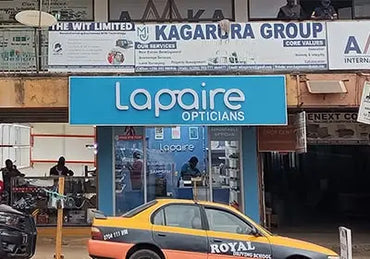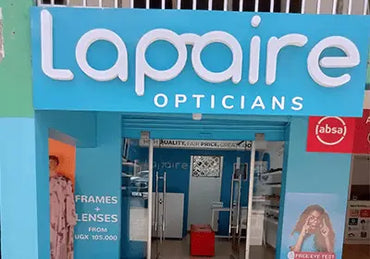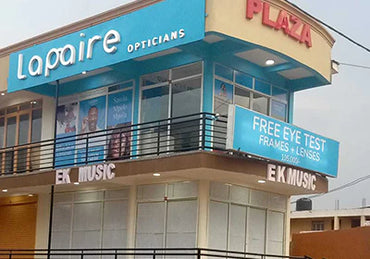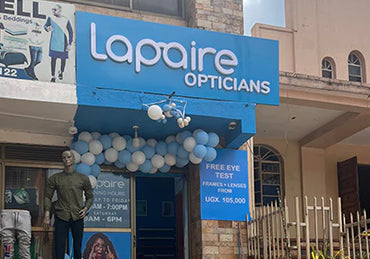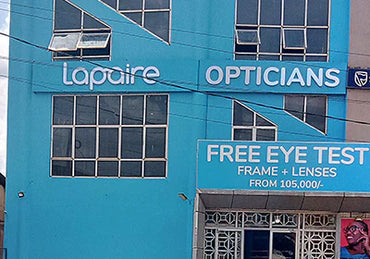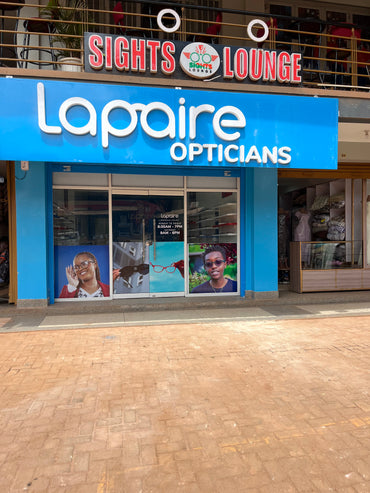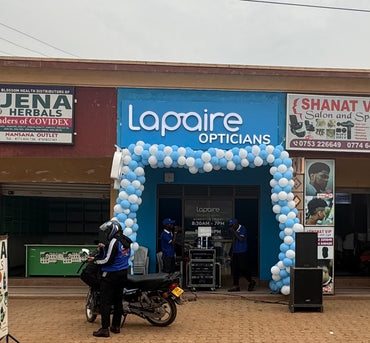Complete Guide : Choosing The Right Type of Glasses (Lenses, Frames & Face Shapes) In Africa
Glasses are not just a tool to correct your vision, but they are also a fashion accessory that enhances your overall look. With so many options available, choosing the right pair of glasses can be an overwhelming task. If you are looking for prescription glasses and non prescription glasses, it doesn't matter.
In this article, we'll explore the different types of glasses, lenses, frames, and face shapes to help you make an informed decision. You can also check what are the eyeglasses trends in 2023.
How do I know what type of eyeglasses I need?
-
Consider the size of the frame. Choose frames that are in proportion to your face. Oversized or undersized frames can throw off the balance of your facial features.
-
Look for frames with gentle curves. Round or oval frames complement the soft curves of your face and enhance your natural beauty.
-
Choose frames that are wider than the broadest part of your face. This creates a sense of balance and symmetry.
-
Experiment with different frame materials. Whether you prefer metal or plastic, try different materials to see what looks best on you.
-
Consider the color of the frame. Warm tones, such as red or orange, complement the natural warmth of your skin, while cool tones, such as silver or black, provide a contrast that highlights your features.
-
Pay attention to the bridge of the frame. Look for frames with a bridge that sits comfortably on the bridge of your nose. A well-fitting bridge ensures that your glasses stay in place and don't slip down your nose.
-
Try on different frame shapes. While oval frames are a safe choice, don't be afraid to try out other shapes, such as square or rectangular frames. Experimenting with different shapes can help you find the perfect frame that enhances your features.
What is The Best Frame Shapes for Your Face Shape
Many people wonder what type of glasses frames will best suit their face. The right glasses frames can enhance your features, complement your style, and improve your vision.
In this article, we will explore the different face shapes and the types of glasses frames that are best suited for each shape. Whether you have an oval, round, square, heart, or diamond-shaped face, we will help you find the perfect pair of glasses that fit your face and style.
We will also discuss the various types of glasses frames available, including metal frames, plastic frames, rimless frames, and more.
By understanding your face shape and the different types of glasses frames available, you can make an informed decision and find the perfect pair of glasses that look great and feel comfortable.
Round face shape
A round face shape has soft, circular features with a similar width and length. To add definition, choose frames that are angular and rectangular. Avoid round glasses or oval frames that can make the face appear rounder.
Oval face shape
An oval face shape is well-balanced, with a gently curved forehead and jawline that are roughly equal in width. Most frame shapes suit this face shape, but rectangular or square frames can add definition and complement the natural proportions of the face.
Square face shape
A square face shape has a strong jawline and a broad forehead. To soften the angular features, choose frames that are round or oval. Avoid frames that are too boxy or angular, as they can exaggerate the squareness of the face.
Heart-shaped Face shape
A heart face shape has a wider forehead and a narrower jawline. To balance out the width of the forehead, choose frames that are wider at the bottom. Round or oval frames can complement the natural curves of the face.
Diamond Face shape
A diamond face shape has angular features, with a narrow forehead and jawline, and wider cheekbones. To balance out the features, choose frames that are wider than the cheekbones. Oval or cat-eye frames can soften the angular features and complement the natural curves of the face.
Oblong Face Shape
An oblong face shape has a long, narrow shape with a straight forehead and jawline. To break up the length of the face, choose frames that have a deep or tall lens shape. Avoid frames that are too narrow or shallow, as they can make the face appear longer.
Triangle Face Shape
A triangle face shape has a wider jawline and a narrower forehead. To balance out the width of the jawline, choose frames that are wider at the top. Cat-eye or aviator frames can complement the natural curves of the face and balance out the features.
What are the different types of eyeglass frames & frame shape?
Eyeglass frames are more than just a tool to help you see better and correct vision; they are also a fashion accessory that can enhance your style and complement your facial features. With so many different eyeglass frames types and frame shapes available, it can be overwhelming to choose the perfect pair that will suit your needs and personal style. From rimless glasses to full rim eyeglasses, metal to plastic, and everything in between, there is an almost infinite number of options to choose from. Understanding the various types of eyeglass frames and frame shapes available can help you make an informed decision when it comes to selecting the perfect pair of glasses that will not only help you see better but also look great. Because there are so many different frames. In this article, we will provide an overview of the different types of eyeglass frames and frame shapes available, and help you navigate through the world of glasses to find the perfect pair for you.
Rimless Frames
These rimless frames have no rims at all and instead use small screws or metal connectors to hold the lenses in place. They offer a minimalist and lightweight option, and are often used for progressive or multifocal lenses. If you choose rimless glasses, Lapaire have a selection for you.
Semi-Rimless Frames (Clubmaster Browline Glasses)
These semi-rimless frames, otherwise known as browline glasses, have a rim that only partially encircles the lens, with the bottom half of the lens often left exposed. They are also known as "clubmaster" or "browline" frames and are popular for their vintage-inspired look.
Full-Rimmed Frames
These full-rimmed eyeglass frames have a rim that fully encircles the lens, and they are the most common type of frame. They can be made from a variety of materials, such as metal or plastic.
Round Frames
These frames have circular lenses and are a popular choice for retro or vintage-inspired looks. Round glasses are definitely not for everyone, but can portray a nice personnality.
Cat-Eye Shape
These frames have an upswept shape at the outer corners, resembling the shape of a cat's eye. They are popular for their feminine and retro-inspired look.
Rectangular Frames
These frames have a rectangular or square shape and are often made from thick plastic. They can offer a bold and statement-making look.
Oval Frames
Oval glasses have a rounded shape that is wider in the middle and tapers slightly towards the ends. They are a classic and versatile choice that can suit a variety of face shapes, but they are particularly well-suited for people with square or angular faces.
Aviator Frames
These aviator style glasses have a teardrop-shaped lens and are popular for their pilot-inspired look. They are often made from metal and have a thin, wire frame.
Boston Model Frames
Boston model frames, also known as "John Lennon" frames, are characterized by their circular shape and thin metal frame. They are named after the round, wire-rimmed glasses worn by the musician and activist. These frames offer a retro and classic look and are often chosen for their unique style. They can be made from a variety of materials, such as stainless steel or titanium, and may come in different finishes, such as matte or shiny. Boston model frames can suit a variety of face shapes, but are particularly well-suited for those with heart-shaped or triangular faces.
What are the types of eyeglass lenses materials ?
As said earlier, your eyeglasses are not just a tool to help you see better, but also an accessory that can enhance your overall look. And while the glasses frames you choose are certainly important, it's the prescription lenses that do the heavy lifting when it comes to correcting your vision. There are several different types of eyeglass lens materials available, each with its unique benefits and drawbacks. Understanding these options can help you make an informed decision when choosing the right lenses for your prescription, lifestyle, and budget. In this article, we will explore the various types of eyeglass lenses materials available and provide an overview of their features and advantages. So whether you are looking to upgrade your current eyeglasses or are a first-time wearer, read on to discover the world of eyeglass lenses and find the best option for your needs. Wear glasses and get the right vision correction for you.
Glass Lenses
Glass lenses were once the most common type of lens material, but they are less popular today due to their weight and fragility. Glass lenses offer excellent optical clarity, but they are heavy and can easily break or shatter, making them less practical than other materials.
Plastic Lenses
Plastic lenses are the most commonly used lens material today. They are lightweight, impact-resistant, and affordable. Plastic lenses can be made from a variety of materials, including CR-39 (a type of polymer), polycarbonate, and Trivex. CR-39 is the most basic and affordable type of plastic lens, while polycarbonate and Trivex are both highly impact-resistant and are often used for safety glasses or sports eyewear.
Single vision Lenses
Single vision lenses are eyeglass lenses that are designed to correct a single vision problem, either nearsightedness (myopia), farsightedness (hyperopia), or astigmatism. These lenses have the same optical power throughout the entire lens and are used to correct one vision problem. They are the simplest and most common type of eyeglass lenses.
Bifocal lenses
Bifocal lenses are lenses that contain two different optical powers in one lens. The upper portion of the lens corrects distance vision, while the lower portion corrects near vision. This type of lens is often used by individuals who have both near and distance vision problems, such as presbyopia, which is an age-related condition that affects the eye's ability to focus on near objects.
Optical lenses
Optical lenses refer to any type of lens that is designed to correct vision problems. This includes single vision lenses, bifocal lenses, and progressive lenses. Optical lenses are made from a variety of materials, such as glass or plastic, and come in different types, including clear, tinted, and photochromic (light-sensitive) lenses. They are typically prescribed by an optometrist or ophthalmologist based on an individual's specific vision needs. Optical lenses can help improve vision, reduce eye strain, and enhance visual clarity.
Polycarbonate Lenses
Polycarbonate lenses are a type of plastic lens that is highly impact-resistant and lightweight. They are a popular choice for children's eyewear, safety glasses, and sports eyewear. Polycarbonate lenses are also highly scratch-resistant and offer 100% UV protection.
High-Index Plastic Lenses
High-index plastic lenses are a type of plastic lens that is thinner and lighter than standard plastic lenses. They are often used for people with high prescriptions, as they can reduce the thickness of the lens and improve the appearance of the glasses.
Photochromatic
Photochromic lenses, also known as transition lenses, are lenses that darken in response to sunlight or UV light. They offer the convenience of having both prescription glasses and sunglasses in one, and are a popular choice for people who spend a lot of time outdoors.
Polarized lenses
Polarized lenses, or in other words sunglass lenses, are tinted lenses that are designed to reduce glare and improve visual clarity. They are a popular choice for people who spend time on the water or in other bright environments, as they can reduce the amount of glare reflected off surfaces.
Progressive lenses
Progressive lenses, also known as multifocal lenses, are lenses that offer multiple vision correction in one lens. Unlike traditional bifocals, which have a visible line separating the distance and near correction, progressive lenses have a seamless transition between the different powers of the lens. This makes them a popular choice for people with presbyopia, as they can correct both distance and near vision in one lens. However, some people may experience a brief period of adjustment when first wearing progressive lenses.
Digital Protection (Blue Light Blocking)
Digital protection lenses, also known as blue light blocking glasses, are lenses that are designed to reduce the amount of blue light emitted by digital devices such as smartphones, tablets, and a computer screen. Blue light can cause eye strain and disrupt sleep patterns, so these lenses can be a good choice for people who spend a lot of time in front of digital screens. Some digital protection lenses have a slight yellow or amber tint, which can help reduce the glare and improve contrast. However, it's worth noting that not all blue light is bad for you - some studies suggest that blue light exposure during the day can improve mood and energy levels. As such, these lenses may not be necessary for everyone.
What type of glasses make you look younger?
There are several types of eyeglasses that can make you look younger. For example, choosing glasses with a thinner and lighter frame can create a more youthful appearance. Rimless or semi-rimless frames can also be a good option, as they can give the impression of having less weight on the face. Choosing eyeglasses with a bright and trendy color can also give a more youthful appearance.
Another option to consider is progressive lenses, which allow for a seamless transition from near to far vision without the need for a visible line in the lens. This can help to avoid the "granny glasses" stereotype and make you look more modern and youthful.
Overall, choosing the right eyeglasses to make you look younger can depend on your individual face shape, style preferences, and personal taste. It's important to try on different styles and get feedback from friends and family to find the best fit for you.
What shape glasses are fashionable?
Fashion trends for eyeglass frames can change from season to season, but some popular frame shapes that have remained fashionable over time include round, square, and cat-eye frames. Round frames can add a retro and playful vibe to your look, while square frames can give a classic and sophisticated appearance. Cat-eye frames can bring a feminine and chic touch to any outfit. However, it's important to note that fashion is subjective, and what looks fashionable on one person might not suit another. It's always best to try on different frame shapes and styles to find the one that suits your personal style and complements your face shape.
Conclusion
In conclusion, choosing the right pair of glasses frames and lens material for your prescription, face shape, and personal style is crucial to ensuring you wear eyeglasses comfortably and confidently. With an ever-increasing need for protective eyewear, glasses frames come in a variety of styles, from traditional full-rimmed frames to rimless frames, and even safety glasses for specific occupations. Whether you require prescription glasses or non-prescription glasses, lens materials such as polycarbonate lenses or high-index plastic lenses can help reduce digital eye strain and provide additional protection. It is important to keep in mind that a trendy frames style may not always be the most practical for your everyday needs, but there are always options to strike a balance between function and fashion. By following the tips and tricks outlined in this complete guide to choosing the right eyeglasses for you, you can make an informed decision when it comes to selecting the perfect pair of glasses frames and lenses to enhance your vision and personal style.






